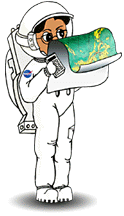| |
The Moon: Earth's Satellite |
| |
The Moon: Earth's Satellite |
![]()
 |
Wow!A crater containing a pond of ice was recently discovered on the dark side of the Moon. The crater is believed to be twice the size of Puerto Rico and deeper than Mt. Everest is high! The ice is believed to be a remnant of a comet which crashed into the Moon 3.6 billion years ago. |
| The Moon travels around Earth in an oval orbit at 3680 kilometers per hour. The Moon does not have an atmosphere, so temperatures range from -184 degrees Celsius during its night to 214 degrees Celsius during its day except at the poles where the temperature is a constant -96 degrees Celsius. The Moon is actually a little lopsided due to the lunar crust being thicker on one side than the other. When you look at the Moon, you will see dark and light areas. The dark areas are young plains called maria and are composed of basalt. The basalt flowed in and flooded the area created by a huge impact with an asteroid or comet. The light areas are the highlands, which are mountains that were uplifted as a result of impacts. The lunar surface is covered by a fine-grained soil called "regolith" which results from the constant bombardment of the lunar rocks by small meteorites. Scientists theorize that the Moon was the result of a collision between Earth and an object the size of Mars. One theory states that the debris from the impact was hurtled into space where, due to gravity, it combined. This resulted in the formation of the Moon. The gravitational pull of the Moon on the Earth affects the ocean tides on Earth. The closer the Moon is to Earth, the greater the effect. The time between high tides is about 12 hours and 25 minutes. |
|
![]() Tell me more about the phases of the Moon!
Tell me more about the phases of the Moon!
A QuestionWhen we look at the Moon, it has light and dark areas which give it the appearance of a man's face. In actuality, what are the light and dark areas? |
| The Facts |
Did you know? |
The Answer |
![]()
| Show me the Level 1 version of this page. |
The StarChild site is a service of the High Energy Astrophysics Science Archive Research Center (HEASARC), within the Astrophysics Science Division (ASD) at NASA/ GSFC.
StarChild Authors: The StarChild Team
StarChild Graphics & Music: Acknowledgments
StarChild Project Leader: Dr. Laura A.
Whitlock
Curator:
Responsible NASA Official: